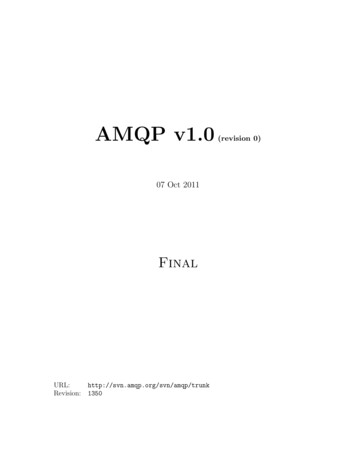
Transcription
AMQP v1.007 Oct ision: 1350(revision 0)
AMQP v1.0 - FinalCopyright Notice(c) Copyright Bank of America, N.A., Barclays Bank PLC, Cisco Systems, Credit Suisse, Deutsche Boerse, EnvoyTechnologies Inc., Goldman Sachs, HCL Technologies Ltd, IIT Software GmbH, iMatix Corporation, INETCO SystemsLimited, Informatica Corporation, JPMorgan Chase & Co., Kaazing Corporation, N.A, Microsoft Corporation,my-Channels, Novell, Progress Software, Red Hat Inc., Software AG, Solace Systems Inc., StormMQ Ltd., TervelaInc., TWIST Process Innovations Ltd, VMware, Inc., and WS02 Inc.2006-2011. All rights reserved.LicenseBank of America, N.A., Barclays Bank PLC, Cisco Systems, Credit Suisse, Deutsche Boerse, Goldman Sachs, HCLTechnologies Ltd, IIT Software GmbH, INETCO Systems Limited, Informatica Corporation, JPMorgan Chase & Co.,Kaazing Corporation, N.A, Microsoft Corporation, my-Channels, Novell, Progress Software, Red Hat Inc., Software AG,Solace Systems Inc., StormMQ Ltd., Tervela Inc., TWIST Process Innovations Ltd, VMware, Inc., and WS02 Inc.(collectively, the "Authors") each hereby grants to you a worldwide, perpetual, royalty-free, nontransferable,nonexclusive license to (i) copy, display, distribute and implement the Advanced Message Queuing Protocol ("AMQP")Specification and (ii) the Licensed Claims that are held by the Authors, all for the purpose of implementing theAdvanced Message Queuing Protocol Specification. Your license and any rights under this Agreement will terminateimmediately without notice from any Author if you bring any claim, suit, demand, or action related to the AdvancedMessag Queuing Protocol Specification against any Author. Upon termination, you shall destroy all copies of theAdvanced Message Queuing Protocol Specification in your possession or control.As used hereunder, "Licensed Claims" means those claims of a patent or patent application, throughout the world,excluding design patents and design registrations, owned or controlled, or that can be sublicensed without fee andin compliance with the requirements of this Agreement, by an Author or its affiliates now or at any future time andwhich would necessarily be infringed by implementation of the Advanced Message Queuing Protocol Specification. Aclaim is necessarily infringed hereunder only when it is not possible to avoid infringing it because there is noplausible non-infringing alternative for implementing the required portions of the Advanced Messag Queuing ProtocolSpecification. Notwithstanding the foregoing, Licensed Claims shall not include any claims other than as set forthabove even if contained in the same patent as Licensed Claims; or that read solely on any implementations of anyportion of the Advanced Message Queuing Protocol Specification that are not required by the Advanced Message QueuingProtocol Specification, or that, if licensed, would require a payment of royalties by the licensor to unaffiliatedthird parties. Moreover, Licensed Claims shall not include (i) any enabling technologies that may be necessary tomake or use any Licensed Product but are not themselves expressly set forth in the Advanced Message Queuing ProtocolSpecification (e.g., semiconductor manufacturing technology, compiler technology, object oriented technology,networking technology, operating system technology, and the like); or (ii) the implementation of other publishedstandards developed elsewhere and merely referred to in the body of the Advanced Message Queuing ProtocolSpecification, or (iii) any Licensed Product and any combinations thereof the purpose or function of which is notrequired for compliance with the Advanced Message Queuing Protocol Specification. For purposes of this definition,the Advanced Message Queuing Protocol Specification shall be deemed to include both architectural andinterconnection requirements essential for interoperability and may also include supporting source code artifactswhere such architectural, interconnection requirements and source code artifacts are expressly identified as beingrequired or documentation to achieve compliance with the Advanced Message Queuing Protocol Specification.As used hereunder, "Licensed Products" means only those specific portions of products (hardware, software orcombinations thereof) that implement and are compliant with all relevant portions of the Advanced Message QueuingProtocol Specification.The following disclaimers, which you hereby also acknowledge as to any use you may make of the Advanced MessageQueuing Protocol Specification:THE ADVANCED MESSAGE QUEUING PROTOCOL SPECIFICATION IS PROVIDED "AS IS," AND THE AUTHORS MAKE NO REPRESENTATIONS ORWARRANTIES, EXPRESS OR IMPLIED, INCLUDING, BUT NOT LIMITED TO, WARRANTIES OF MERCHANTABILITY, FITNESS FOR APARTICULAR PURPOSE, NON-INFRINGEMENT, OR TITLE; THAT THE CONTENTS OF THE ADVANCED MESSAGE QUEUING PROTOCOLSPECIFICATION ARE SUITABLE FOR ANY PURPOSE; NOR THAT THE IMPLEMENTATION OF THE ADVANCED MESSAGE QUEUING PROTOCOLSPECIFICATION WILL NOT INFRINGE ANY THIRD PARTY PATENTS, COPYRIGHTS, TRADEMARKS OR OTHER RIGHTS.THE AUTHORS WILL NOT BE LIABLE FOR ANY DIRECT, INDIRECT, SPECIAL, INCIDENTAL OR CONSEQUENTIAL DAMAGES ARISING OUT OFOR RELATING TO ANY USE, IMPLEMENTATION OR DISTRIBUTION OF THE ADVANCED MESSAGE QUEUING PROTOCOL SPECIFICATION.The name and trademarks of the Authors may NOT be used in any manner, including advertising or publicity pertainingto the Advanced Message Queuing Protocol Specification or its contents without specific, written prior permission.Title to copyright in the Advanced Message Queuing Protocol Specification will at all times remain with the Authors.No other rights are granted by implication, estoppel or otherwise.Upon termination of your license or rights under this Agreement, you shall destroy all copies of the AdvancedMessage Queuing Protocol Specification in your possession or control.Trademarks"JPMorgan", "JPMorgan Chase", "Chase", the JPMorgan Chase logo and the Octagon Symbol are trademarks of JPMorganChase & Co.RED HAT is a registered trademarks of Red Hat, Inc. in the US and other countries.other countries, or both.Other company, product, or service names may be trademarks or service marks of others.Link to full AMQP y/AMQP/AMQP SpecificationAMQP Specification v1.0Revision : 1350 (07 Oct 2011)Page 1 of 112
AMQP v1.0 - FinalContentsContentsIntroduction . . . . . . . . . . . . . . . . . . . . . . . . . . . . . . . . . . . . . . . . . . . . .1 Types1.1 Type System . . . . . . .1.1.1 Primitive Types .1.1.2 Described Types .1.1.3 Descriptor Values .1.2 Type Encodings . . . . . .1.2.1 Fixed Width . . .1.2.2 Variable Width . .1.2.3 Compound . . . .1.2.4 Array . . . . . . .1.2.5 List Of Encodings1.3 Composite Types . . . . .1.3.1 List Encoding . . .6.999101010131718192021222 Transport2.1 Transport . . . . . . . . . . . . . . . . . . .2.2 Version Negotiation . . . . . . . . . . . . .2.3 Framing . . . . . . . . . . . . . . . . . . . .2.3.1 Frame Layout . . . . . . . . . . . . .2.3.2 AMQP Frames . . . . . . . . . . . .2.4 Connections . . . . . . . . . . . . . . . . . .2.4.1 Opening A Connection . . . . . . . .2.4.2 Pipelined Open . . . . . . . . . . . .2.4.3 Closing A Connection . . . . . . . .2.4.4 Simultaneous Close . . . . . . . . . .2.4.5 Idle Time Out Of A Connection . .2.4.6 Connection States . . . . . . . . . .2.4.7 Connection State Diagram . . . . . .2.5 Sessions . . . . . . . . . . . . . . . . . . . .2.5.1 Establishing A Session . . . . . . . .2.5.2 Ending A Session . . . . . . . . . . .2.5.3 Simultaneous End . . . . . . . . . .2.5.4 Session Errors . . . . . . . . . . . . .2.5.5 Session States . . . . . . . . . . . . .2.5.6 Session Flow Control . . . . . . . . .2.6 Links . . . . . . . . . . . . . . . . . . . . . .2.6.1 Naming A Link . . . . . . . . . . . .2.6.2 Link Handles . . . . . . . . . . . . .2.6.3 Establishing Or Resuming A Link .2.6.4 Detaching And Reattaching A Link2.6.5 Link Errors . . . . . . . . . . . . . 04243AMQP Specification v1.0.Revision : 1350 (07 Oct 2011)Page 2 of 112
AMQP v1.0 - Final2.72.8Contents2.6.6 Closing A Link . . . . . . . .2.6.7 Flow Control . . . . . . . . .2.6.8 Synchronous Get . . . . . . .2.6.9 Asynchronous Notification . .2.6.10 Stopping A Link . . . . . . .2.6.11 Messages . . . . . . . . . . .2.6.12 Transferring A Message . . .2.6.13 Resuming Deliveries . . . . .2.6.14 Transferring Large MessagesPerformatives . . . . . . . . . . . . .2.7.1 Open . . . . . . . . . . . . .2.7.2 Begin . . . . . . . . . . . . .2.7.3 Attach . . . . . . . . . . . . .2.7.4 Flow . . . . . . . . . . . . . .2.7.5 Transfer . . . . . . . . . . . .2.7.6 Disposition . . . . . . . . . .2.7.7 Detach . . . . . . . . . . . . .2.7.8 End . . . . . . . . . . . . . .2.7.9 Close . . . . . . . . . . . . .Definitions . . . . . . . . . . . . . . .2.8.1 Role . . . . . . . . . . . . . .2.8.2 Sender Settle Mode . . . . .2.8.3 Receiver Settle Mode . . . . .2.8.4 Handle . . . . . . . . . . . . .2.8.5 Seconds . . . . . . . . . . . .2.8.6 Milliseconds . . . . . . . . . .2.8.7 Delivery Tag . . . . . . . . .2.8.8 Delivery Number . . . . . . .2.8.9 Transfer Number . . . . . . .2.8.10 Sequence No . . . . . . . . .2.8.11 Message Format . . . . . . .2.8.12 IETF Language Tag . . . . .2.8.13 Fields . . . . . . . . . . . . .2.8.14 Error . . . . . . . . . . . . .2.8.15 AMQP Error . . . . . . . . .2.8.16 Connection Error . . . . . . .2.8.17 Session Error . . . . . . . . .2.8.18 Link Error . . . . . . . . . .2.8.19 Constant Definitions . . . . .3 Messaging3.1 Introduction . . . . . . . . . .3.2 Message Format . . . . . . .3.2.1 Header . . . . . . . . .3.2.2 Delivery Annotations .3.2.3 Message Annotations .3.2.4 Properties . . . . . . .3.2.5 Application Properties3.2.6 Data . . . . . . . . . .3.2.7 AMQP Sequence . . .3.2.8 AMQP Value . . . . .3.2.9 Footer . . . . . . . . .3.2.10 Annotations . . . . . .3.2.11 Message ID ULong . .AMQP Specification 797979797980Revision : 1350 (07 Oct 2011)Page 3 of 112
AMQP v1.0 - 919292939393949494944 Transactions4.1 Transactional Messaging . . . . . . . . . . . . . . . .4.2 Declaring a Transaction . . . . . . . . . . . . . . . .4.3 Discharging a Transaction . . . . . . . . . . . . . . .4.4 Transactional Work . . . . . . . . . . . . . . . . . . .4.4.1 Transactional Posting . . . . . . . . . . . . .4.4.2 Transactional Retirement . . . . . . . . . . .4.4.3 Transactional Acquisition . . . . . . . . . . .4.4.4 Interaction Of Settlement With Transactions4.4.4.1 Transactional Posting . . . . . . . .4.4.4.2 Transactional Retirement . . . . . .4.4.4.3 Transactional Acquisition . . . . . .4.5 Coordination . . . . . . . . . . . . . . . . . . . . . .4.5.1 Coordinator . . . . . . . . . . . . . . . . . . .4.5.2 Declare . . . . . . . . . . . . . . . . . . . . .4.5.3 Discharge . . . . . . . . . . . . . . . . . . . .4.5.4 Transaction ID . . . . . . . . . . . . . . . . .4.5.5 Declared . . . . . . . . . . . . . . . . . . . . .4.5.6 Transactional State . . . . . . . . . . . . . . .4.5.7 Transaction Capability . . . . . . . . . . . . .4.5.8 Transaction Error . . . . . . . . . . . . . . 1041045 Security5.1 Security Layers . . . . . . . . . . . . . . . . . . . . . . . . . . . . . . . . . . . . . . . .5.2 TLS . . . . . . . . . . . . . . . . . . . . . . . . . . . . . . . . . . . . . . . . . . . . . .5.2.1 Alternative Establishment . . . . . . . . . . . . . . . . . . . . . . . . . . . . . .1061061061073.33.43.53.2.12 Message ID UUID . . . . . . . . . . . . . .3.2.13 Message ID Binary . . . . . . . . . . . . . .3.2.14 Message ID String . . . . . . . . . . . . . .3.2.15 Address String . . . . . . . . . . . . . . . .3.2.16 MESSAGE-FORMAT . . . . . . . . . . . .Distribution Nodes . . . . . . . . . . . . . . . . . .3.3.1 Message States . . . . . . . . . . . . . . . .Delivery State . . . . . . . . . . . . . . . . . . . . .3.4.1 Received . . . . . . . . . . . . . . . . . . . .3.4.2 Accepted . . . . . . . . . . . . . . . . . . .3.4.3 Rejected . . . . . . . . . . . . . . . . . . . .3.4.4 Released . . . . . . . . . . . . . . . . . . . .3.4.5 Modified . . . . . . . . . . . . . . . . . . . .3.4.6 Resuming Deliveries Using Delivery States .Sources and Targets . . . . . . . . . . . . . . . . .3.5.1 Filtering Messages . . . . . . . . . . . . . .3.5.2 Distribution Modes . . . . . . . . . . . . . .3.5.3 Source . . . . . . . . . . . . . . . . . . . . .3.5.4 Target . . . . . . . . . . . . . . . . . . . . .3.5.5 Terminus Durability . . . . . . . . . . . . .3.5.6 Terminus Expiry Policy . . . . . . . . . . .3.5.7 Standard Distribution Mode . . . . . . . . .3.5.8 Filter Set . . . . . . . . . . . . . . . . . . .3.5.9 Node Properties . . . . . . . . . . . . . . .3.5.10 Delete On Close . . . . . . . . . . . . . . .3.5.11 Delete On No Links . . . . . . . . . . . . .3.5.12 Delete On No Messages . . . . . . . . . . .3.5.13 Delete On No Links Or Messages . . . . . .AMQP Specification v1.0Revision : 1350 (07 Oct 2011)Page 4 of 112
AMQP v1.0 - ant Definitions . . . . . . . . . . . . . . . . . . .SASL Frames . . . . . . . .SASL Negotiation . . . . .Security Frame Bodies . . .5.3.3.1 SASL Mechanisms5.3.3.2 SASL Init . . . . .5.3.3.3 SASL Challenge .5.3.3.4 SASL Response .5.3.3.5 SASL Outcome . .5.3.3.6 SASL Code . . . .Constant Definitions . . . .AMQP Specification v1.0.Revision : 1350 (07 Oct 2011).107107108109109109110110111111111112Page 5 of 112
AMQP v1.0 - FinalContentsIntroductionOverviewThe Advanced Message Queuing Protocol is an open Internet Protocol for Business Messaging.AMQP is divided up into separate layers. At the lowest level we define an efficient binary peer-to-peerprotocol for transporting messages between two processes over a network. Secondly we define anabstract message format, with concrete standard encoding. Every compliant AMQP process must beable to send and receive messages in this standard encoding.Rationale and Use CasesA community of business messaging users defined the requirements for AMQP based on their experiences of building and operating networked information processing systems.The AMQP Working Group measures the success of AMQP according to how well the protocol satisfiesthese requirements, as outlined below.Ubiquity1.01.0Open Internet protocol standard supporting unencumbered (a) use, (b) implementation, and (c) extensionClear and unambiguous core functionality for business message routing and deliverywithin Internet infrastructure - so that business messaging is provided by infrastructure and not by integration expertsLow barrier to understand, use and implementFits into existing enterprise messaging applications environments in a practical waySafety1.0Infrastructure for a secure and trusted global transaction network Consisting of business messages that are tamper proof Supporting message durability independent of receivers being connected, and Message delivery is resilient to technical failure1.0Supports business requirements to transport business transactions of any financialvalueSender and Receiver are mutually agreed upon counter parties - No possibility forinjection of SpamFutureAMQP Specification v1.0Revision : 1350 (07 Oct 2011)Page 6 of 112
AMQP v1.0 - FinalIntroductionFidelity1.01.01.0Well-stated message queueing and delivery semantics covering: at-most-once; at-leastonce; and once-and-only-once aka ’reliable’Well-stated message ordering semantics describing what a sender can expect (a) areceiver to observe and (b) a queue manager to observeWell-stated reliable failure semantics so all exceptions can be managedApplicability1.0Future1.01.0FutureAs TCP subsumed all technical features of networking, we aspire for AMQP to bethe prevalent business messaging technology (tool) for organizations so that withincreased use, ROI increases and TCO decreasesAny AMQP
AMQP v1.0 - Final Contents Introduction Overview The Advanced Message Queuing Protocol is an open Internet Protocol for Bus

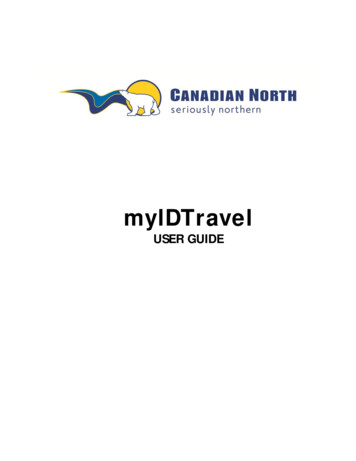
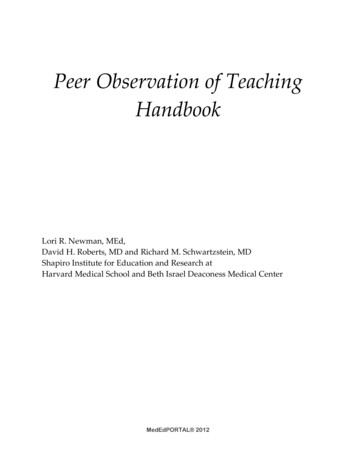
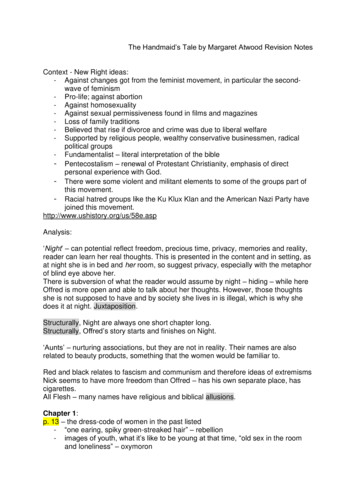
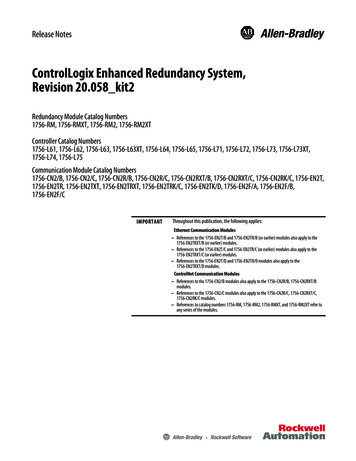
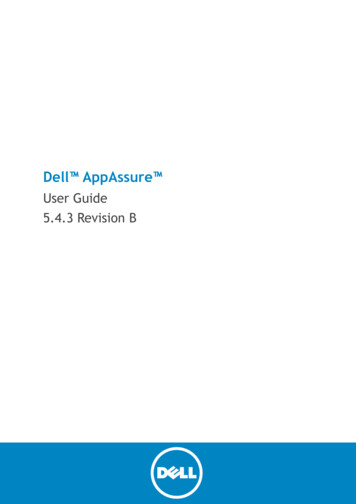
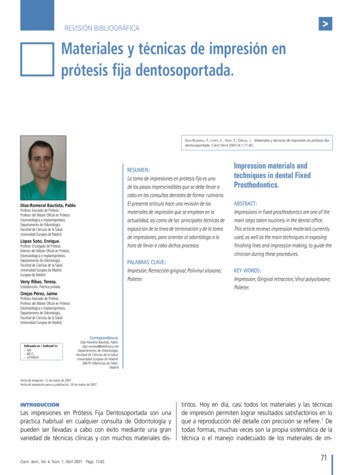
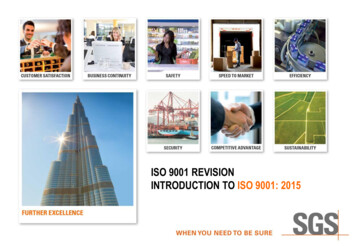
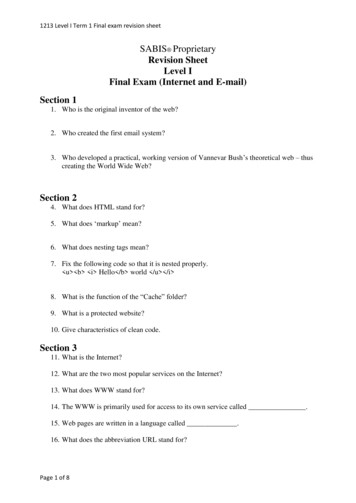
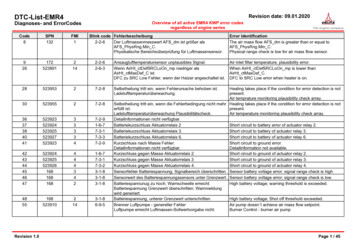
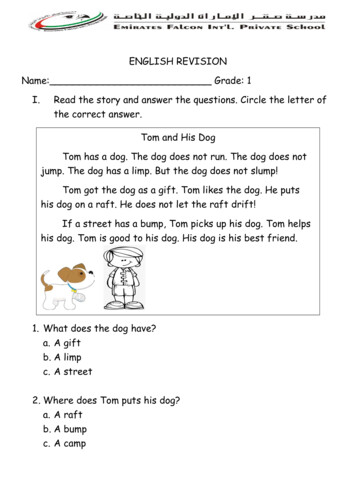
![First Revision No. 147-NFPA 20-2013 [ Global Input ]](/img/4/20-a15-fim-aaa-fd-frstatements.jpg)